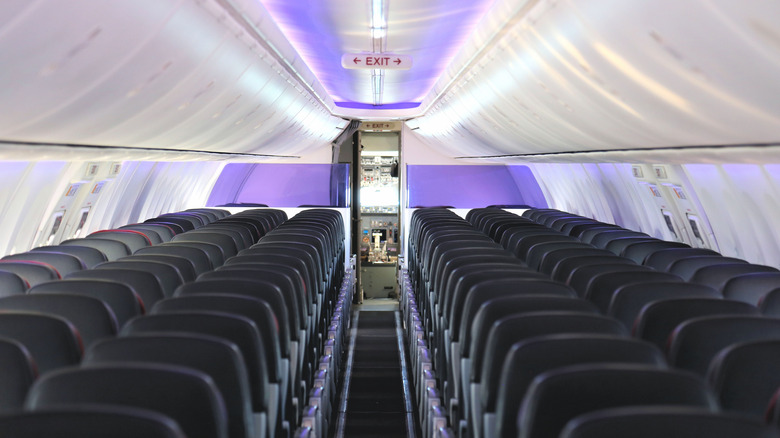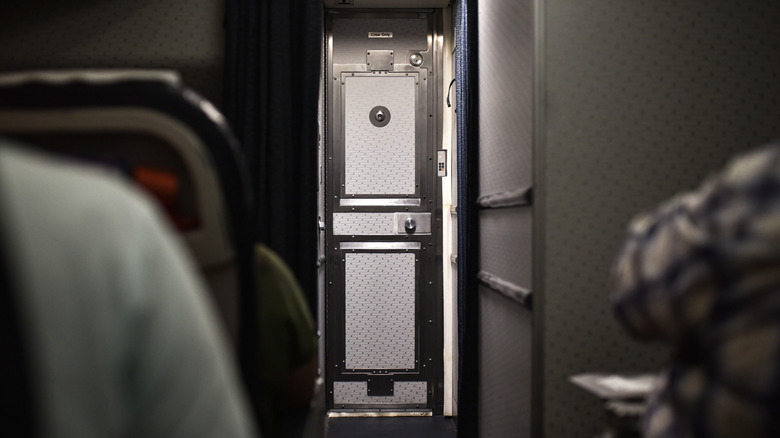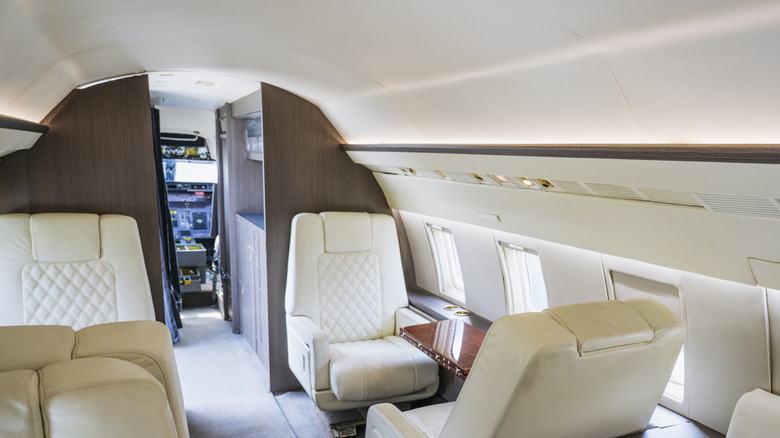This Is Why Pilots Leave Their Cockpit Doors Open Before Takeoff
Most travelers probably didn't give much thought to the security of airliner cockpits before the 9/11 attacks, and since then it might seem odd to some that cockpit doors are often left wide open while passengers board and deplane. This is customary to facilitate efficient communication between pilots, ground crew, and cabin crew, which are important when a flight is on the ground before departure and after arrival. The time before a plane takes off is an especially busy one, necessitating a constant exchange of information between pilots, gate agents, and other ground personnel like baggage handlers and maintenance crews.
Some of this communication can be done via two-way radio, but being able to get face to face makes for clearer communication and the ability to hand off any physical objects that need to be exchanged. Leaving the cockpit door open allows various personnel to duck in and talk to the pilots directly if they choose, and flight attendants are usually just outside to deter passengers from getting disruptively curious. While the cockpit door is open, information like fuel status, weather conditions, and passenger count can be verified via face-to-face conversation. Additionally, some changes to flight plans may require ground personnel to enter the cockpit to hand off paperwork or confirm changes. Maintenance crews might also need to perform last-minute checks or maintenance before a flight is cleared for takeoff, and an open cockpit door saves precious seconds. For U.S-based flights, cockpit doors must be closed and locked for security reasons before a flight backs away from the gate.
Cockpit security falls under federal law in the United States
According to the U.S. Code of Federal Regulations Title 14 section 121.587, pilots "shall ensure that the door separating the flight crew compartment from the passenger compartment is closed and locked at all times when the aircraft is being operated ... [except] when it is necessary to permit access and egress by persons authorized in accordance with § 121.547 and provided the part 119 operator complies with FAA approved procedures regarding the opening, closing and locking of the flightdeck doors."
This applies to all commercial flights, even those on the 50-seat Embraer ERJ-135 and Bombardier CRJ-200, the smallest commercial jets in the sky. These planes are generally used for regional flights while larger aircraft like the Boeing 747 and Airbus A300 are common for transcontinental or international voyages. Flights on any of these planes might require last-minute in-person communication with pilots before takeoff, so cockpit doors often stay open until the moment that the law requires they be closed and locked.
Do private jets follow the same rule?
You might be wondering if private plane operators adhere to the same policies, and the answer is complicated. First of all, many private jets — especially smaller ones — don't even have a door to separate the flight deck from the passenger cabin. On the other hand, some of the largest private jets in the world are converted former airliners that have hardened cockpit doors in accordance with federal regulations. Hardened cockpit doors are bullet- and explosive-resistant and can withstand 1,500 pounds of force without opening or breaking. Many converted commercial airlines are not owned by wealthy sports stars or entertainers but by national governments to carry heads of state, other dignitaries, and their entourages. In these cases, rules regarding cockpit door procedures might change as a plane travels from country to country. Although these standards are effective in fostering safe, efficient transportation, they don't apply to all flights. In a post on the Air Line Pilot's Association website, the organization demanded more consistency regarding cockpit doors from the Federal Aviation Administration (FAA) and U.S. Congress.
The union that represents more than 80,000 pilots specifically called for the mandated use of secondary barriers, which are retractable gates separating the passenger cabin from the forward galley and flight deck. Secondary doors were mandated on new aircraft shorty after the 9/11 attacksm but operatos weren't required to install them on existing planes. The ALPA also requested hardened cockpit doors to be required on cargo flights, which "are not required to have intrusion-resistant flight deck doors, despite carrying crewmembers and non-flight personnel onboard." These regulations and best practices are constantly being re-evaluated and updated, so don't be surprised if more changes come soon and you lose your chance to peek at the controls while boarding.


